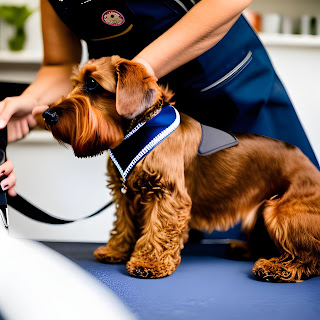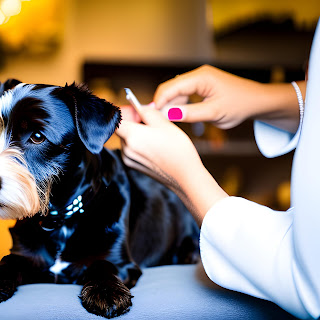Hand Stripping: The Ultimate Grooming Guide for Specific Dog Breeds
Grooming is an essential aspect of maintaining your dog's overall health and well-being. One such grooming technique, known as hand stripping, is particularly important for certain dog breeds. In this comprehensive guide, we will explore the grooming process of hand stripping, its benefits, and the dog breeds that require this specialized method.
One of the main benefits of hand stripping is that it allows the coat to grow back in its natural state. When a dog's coat is clipped or shaved, it can alter the texture and color of the hair. Hand stripping preserves the natural look and feel of the coat, which is important for show dogs and pets alike.
The grooming process of hand stripping involves using a special tool called a stripping knife. The knife is used to gently pull out the dead hairs from the dog's coat, leaving the healthy hairs intact. This process can be time-consuming and requires a skilled hand, but it is essential for maintaining the appearance and health of certain breeds.
1. What is Hand Stripping?
Hand stripping is a grooming technique that involves removing dead hair from your dog's coat by hand or using specialized tools. This process helps maintain the natural texture and color of your dog's fur while promoting new hair growth. Hand stripping is different from regular brushing or clipping, as it preserves the coat's integrity and prevents damage to the hair follicles.
2. Benefits of Hand Stripping
- Maintains the natural texture and color of your dog's coat
- Promotes healthy hair growth
- Reduces shedding
- Prevents matting and tangling
- Enhances your dog's overall appearance
3. Dog Breeds That Require Hand Stripping
While hand stripping is suitable for most wire-haired or rough-coated dog breeds, some breeds particularly benefit from this grooming method.
These include:
- Airedale Terrier - The Airedale Terrier has a wiry topcoat that grows continuously and a soft undercoat. Hand stripping is necessary for Airedale Terriers to remove the dead hairs from the topcoat and promote healthy hair growth. Hand stripping also helps to maintain the texture and color of the coat, and prevents it from becoming too soft or curly. In addition, hand stripping can help to prevent skin irritations and infections that can occur when dead hairs are left in the coat. Regular hand stripping is important for Airedale Terriers to maintain a healthy and well-groomed appearance.
- Border Terrier - The Border Terrier has a wiry topcoat that grows continuously and can become matted and tangled if not properly groomed. Hand stripping is necessary for Border Terriers to remove the dead hairs from the coat and prevent matting. Hand stripping also helps to maintain the texture and color of the coat, and prevents it from becoming too soft or curly. In addition, hand stripping can help to prevent skin irritations and infections that can occur when dead hairs are left in the coat.
- Cairn Terrier - The Cairn Terrier has a wiry topcoat that grows continuously. Hand stripping is necessary for Cairn Terriers to remove the dead hairs from the coat and promote healthy hair growth. Hand stripping also helps to maintain the texture and color of the coat, and prevents it from becoming too soft or curly. In addition, hand stripping can help to prevent skin irritations and infections that can occur when dead hairs are left in the coat.
- Dandie Dinmont Terrier - The Dandie Dinmont Terrier has a unique coat that grows in two layers, with a soft undercoat and a wiry topcoat. Hand stripping is a grooming technique that involves pulling out the dead hairs from the topcoat by hand, rather than cutting them with clippers. This helps to maintain the texture and color of the coat, and also promotes healthy hair growth. Hand stripping is necessary for Dandie Dinmont Terriers to maintain their characteristic appearance and texture.
- Irish Terrier - The Irish Terrier has a wiry topcoat that grows continuously and a soft undercoat. Hand stripping is necessary for Irish Terriers to remove the dead hairs from the topcoat and promote healthy hair growth. Hand stripping also helps to maintain the texture and color of the coat, and prevents it from becoming too soft or curly. In addition, hand stripping can help to prevent skin irritations and infections that can occur when dead hairs are left in the coat. Regular hand stripping is important for Irish Terriers to maintain a healthy and well-groomed appearance.
- Schnauzer - The Schnauzer has a wiry, thick coat that requires regular hand stripping to keep it looking neat and tidy. Hand stripping is one of the grooming methods that can be used for the Schnauzer breed, but it is not always necessary. Some Schnauzers have a softer coat that can be clipped instead of hand stripped. However, if you want to maintain the wiry texture of the coat, hand stripping is recommended.
- Scottish Terrier - The Scottish Terrier breed has a wiry and dense coat that requires regular grooming to maintain its texture and appearance. The coat is typically black, brindle, or wheaten in color, and should be hand stripped a few times a year to remove dead hair and maintain its wiry texture. Hand stripping helps to stimulate new hair growth. Generally, it is recommended to hand strip a Scottish Terrier every 3 to 4 months to maintain the coat's texture and color. However, some dogs may need to be stripped more frequently or less frequently depending on how quickly their coat grows and how much activity they engage in.
- Welsh Terrier - The Welsh Terrier breed has a wiry and dense coat that requires regular grooming to maintain its texture and appearance. The coat is typically black and tan or black and grizzle in color, and should be hand stripped a few times a year to remove dead hair and maintain its wiry texture. Welsh Terriers are typically hand stripped to maintain their wiry coat. This is because hand stripping helps to preserve the texture and color of the coat, as well as stimulate new hair growth. Clipping the coat can cause it to become softer and lose its distinctive texture.
- Wire Fox Terrier - The Wire Fox Terrier has a wiry topcoat that grows continuously and is prone to matting and tangling. Hand stripping is necessary for Wire Fox Terriers to remove the dead hairs from the coat and prevent matting. Hand stripping also helps to maintain the texture and color of the coat, and prevents it from becoming too soft or curly. In addition, hand stripping can help to prevent skin irritations and infections that can occur when dead hairs are left in the coat.
How to Hand Strip Your Dog's Coat
Before attempting hand stripping, it's essential to consult with a professional groomer or your veterinarian, as improper technique can cause discomfort or harm to your dog. Here are the basic steps to hand strip your dog's coat:
a) Prepare Your Dog: Ensure your dog is relaxed and comfortable. Begin by brushing their coat to remove any loose hair or debris.
b) Start at the Head: Working in small sections, gently pinch a few hairs between your thumb and forefinger, close to the skin. Pull in the direction of hair growth with a firm but gentle motion.
c) Work Your Way Down: Continue hand stripping in sections, moving from the head down to the tail. Be sure to follow the natural direction of hair growth.
d) Use a Stripping Knife: For larger areas or stubborn hair, you can use a stripping knife. Hold the knife at a slight angle and gently glide it through the hair in the direction of growth.
e) Finish with a Brush: Once you have completed hand stripping, brush your dog's coat to remove any remaining loose hairs.
5. Tips for Successful Hand Stripping
- Consult with a professional groomer or veterinarian before attempting hand stripping.
- Be patient and gentle with your dog during the process.
- Use the proper tools designed for hand stripping.
- Regularly maintain your dog's coat to prevent matting and tangling.
Embrace the Benefits of Hand Stripping
Hand stripping is an essential grooming technique for specific dog breeds, offering numerous benefits for both their appearance and overall health. By understanding the process and consulting with professionals, you can ensure your dog receives the proper care they need to maintain a beautiful and healthy coat.
5 FAQs About Hand Stripping a Dog
1. What is hand stripping and why is it done?
Hand stripping is a grooming technique that involves removing the dead outer coat of a dog's fur by hand, rather than using clippers. This helps to maintain the texture and color of the coat, and is often done for show dogs to enhance their appearance.
2. Which breeds benefit from hand stripping?
Breeds with wiry or harsh coats, such as Terriers, Schnauzers, and Spaniels, are typically the best candidates for hand stripping. However, it's important to consult with a professional groomer to determine if your dog's coat is suitable for this technique.
3. Is hand stripping painful for the dog?
When done properly, hand stripping should not be painful for the dog. However, it can be uncomfortable if the groomer is not gentle or if the dog has sensitive skin. It's important to choose a skilled and experienced groomer who knows how to minimize any discomfort.
4. How often should a dog be hand stripped?
The frequency of hand stripping depends on the breed and the individual dog's coat. Some dogs may need to be stripped every few months, while others may only need it once or twice a year. Your groomer can advise you on the best schedule for your dog.
5. Can hand stripping be done at home?
Hand stripping is a specialized technique that requires skill and experience. While it may be possible to learn how to do it yourself, it's generally recommended to have it done by a professional groomer who has been trained in this technique. This will help ensure that your dog's coat is properly cared for and that they are not injured during the process.



